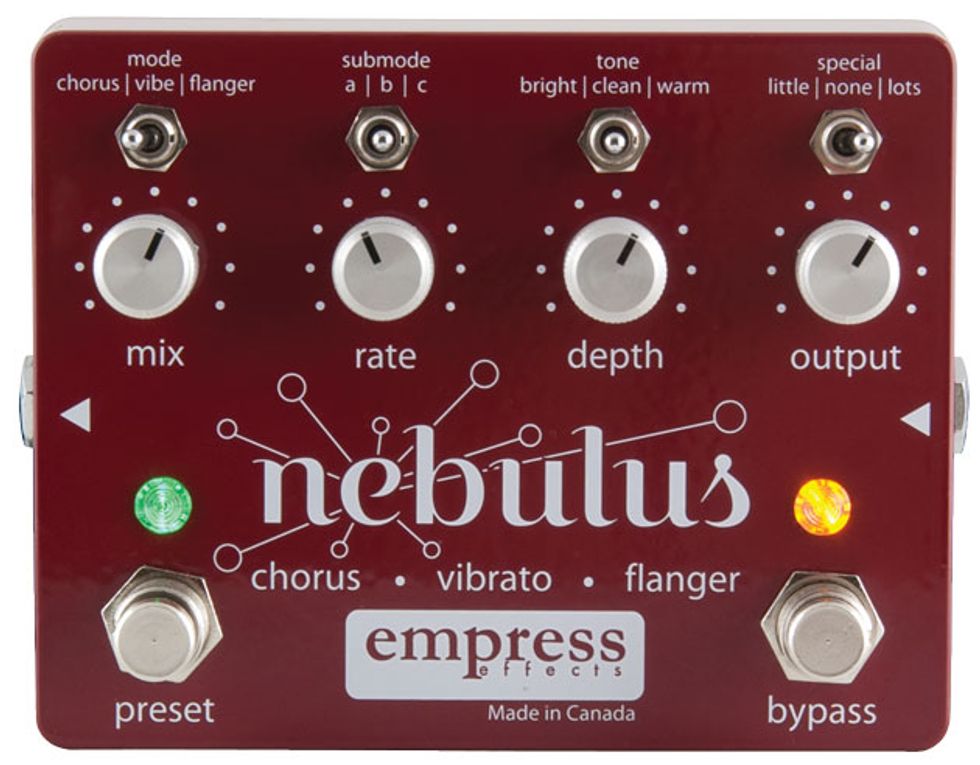Just how many sounds can you cram into a 4.5" x 3.5" stompbox? If you're Empress Effects, the total is well into the double digits. Their new Nebulus aspires to be a do-it-all digital modulation pedal, offering many customizable chorus, flange, and vibrato sounds. Thanks to clever design and virtuosic programming, it largely achieves its goal.
One-Stop Modulation Shop
Exactly how many sounds does the Nebulus do? The answer requires a little math. The pedal includes four three-position mini-switches. One selects between chorus, vibrato, and flanger modes. Another chooses between three preset “sub-modes" for each of the primary modes. The third switch toggles between bright/clean/warm settings, with varying amounts of high-end roll-off. A final switch sets the intensity of one predetermined parameter within each mode, selectable between “little," “none," and “lots." And then there are all the tweaks you can make via the pedal's standard mix, rate, depth, and output knobs. That makes a grand total of…a buttload.
Also onboard: two footswitches for bypass and preset selection. As if it weren't already ambitious enough, the Nebulus lets you store up eight of your sounds in memory, though you can only access them sequentially via foot-tap. (Thankfully, you can choose the desired number of presets. So if, say, you only need two modulation sounds for a set, you don't necessarily need to tap the footswitch seven times to return from preset #2 from preset #1.) A large, eight-color LED indicates the active preset and flashes in tempo with the modulation rate.
Tweaker's Delight
Thanks to those ingenious switches, the Nebulus is far easier to program than it might otherwise be. An effect parameter menu printed on the pedal's side further clarifies the process. But while you don't have to be a tweaker to summon good sounds from the Nebulus, it helps.
Ratings
Pros:
A vast assortment of modulation colors. Small pedalboard footprint.
Cons:
Tweaking required. Tones not quite as rich as the analog circuits they mimic.
Tones:
Playability/Ease of Use:
Build/Design:
Value:
Street:
$299
Empress Nebulus
empresseffects.com
Example: To access the advanced settings, you must power up the pedal while simultaneously pressing the bypass and preset switches, at which point you can enter values via the mini-switches. (If the preceding sentence makes you break out in hives, be sure to try the Nebulus before you buy.)
The pedal requires AC power (between 9 and 12 volts, and at least 300 mA). There's an internal switch that adds an extra 6 dB of padding for loud signals. Workmanship is solid throughout.
Digital Dilemma
The sound quality is par for the latest generation of digitally stompbox effects. In other words, the tones are good, though none of them qualify as “best in class." (That's not a critique of Empress so much as an observation about the current state of the low-cost DSP chip.) You can't obtain quite the smoothness and immersive detail of the classic analog modulation effects or the best of today's computer-hosted plug-ins. The combined dry and delayed signals that create most of these effects can seem colder, smaller, and less harmonious than their analog equivalents. The LFO sweeps that animate them can feel mechanical, and a bit rough as each waveform reaches maximum height and depth.
But while the Nebulus doesn't quite equal the sounds of every classic Boss, Electro-Harmonix, ADA, and Univox pedal it evokes, it provides serviceable approximations, and sometimes it truly shines (as in the lovely Uni-Vibe-inspired setting). For those who don't have access to a large collection of pricy analog pedals or the pachyderm-sized pedalboard needed to accommodate them, the Nebulus may be the perfect compromise.
The Verdict
The Nebulus offers a remarkable array of modulation effects. It's not simple to use, though its ingenious controls make the process as painless as possible. Sound quality is solid, if not quite equal to the best analog effects. It's a good choice for those seeking many modulation colors in a compact stompbox at a competitive price.












![Rig Rundown: Russian Circles’ Mike Sullivan [2025]](https://www.premierguitar.com/media-library/youtube.jpg?id=62303631&width=1245&height=700&quality=70&coordinates=0%2C0%2C0%2C0)







